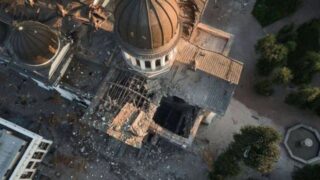One branch of the anarchist sect went from pacifism to violence. It did not represent the whole community.
by Susan J. Palmer
Article 1 of 3


The Doukhobors are virtually unknown outside of Canada, but they present a fascinating case study of a centuries–old Russian Christian sect whose uncompromising commitment to pacifist principles led to violence.
After the sect emigrated to Canada, between 1902 and 1960, it rapidly became clear that the Doukhobors were anarchists who had no intention of becoming patriotic, docile Canadian citizens. Paradoxically, the Doukhobors’ radical pacifism (linked to their communal ideals and hostile stance on literacy) led to a series of violent acts. These acts were perpetrated on each side of a 60-year conflict between a radical group of Doukhobors and the governments who sought to control them.
Infamous in Canada for “parading in the nude,” and for the bombing and torching of factories, schools, police vehicles, and houses, the Doukhobors were prominent in the Canadian media, and politicians in the government of British Columbia were preoccupied with the “Doukhobor Problem.”
In 1952, in response to truancy violations of Doukhobors who refused to send their children to public school, the B.C. government sent in the Royal Canadian Mounted Police to raid their homes and remove their children. This ruthless strategy to assimilate the radical elements in a minority religious culture qualifies as “psychological violence” (towards parents and children) and might be compared to other notorious cases of government policies of forced assimilation.
To investigate what became of those second generation of the Sons of Freedom Doukhobors, two McGill researchers, Susan J. Palmer and Shane Ovadia Dussault conducted a field trip in August 2019 in the Kootenays region of British Columbia, interviewing 16 Doukhobors who spoke of childhood experiences of forced assimilation after the RCMP raids of the 1950s. This research was part of the Children in Sectarian Religions and State Control project, supported by a SSHRC grant from the federal government of Canada.
Who are the Doukhobors? Here is their story.
The Doukhobors are a Russian Christian anarchist pacifist sect, which emigrated to Canada in 1898. It originated in Russia in the 1640s out of Raskol, a great schism reacting to petty reforms in ritual and overweening priestly authority in the Russian Orthodox Church. The first Doukhobors emerged as a mystical movement that spread through the (mainly illiterate) peasant class. Doukhobors (R: “spirit wrestlers”) rejected the sacraments, priestly authority, and “idolatry” of the Orthodox Church—and even the written Bible. Instead, they embraced “Toil and a Peaceful Life”: a simple way of life based on communal living and hard work, led by the Holy Spirit.


Deeply committed to nonviolence and pacifism, they refused to pledge allegiance to any secular government. Their refusal to bear arms led to conflicts with the Tsars. In 1895, over 7,000 Doukhobors across the Caucasus burned their muskets to protest the war and forcible conscription into the Russian army. This event, known as The Burning of Arms, is believed to be the first pacifist protest in modern times, and is still celebrated every April.
Between 1898 and 1903 the Doukhobors emigrated from Russia to Canada to escape conscription into the Russian army. Count Leo Tolstoy, the great Russian novelist, had paid for their voyage.
Tolstoy fell into a deep depression after writing “War and Peace” and “Anna Karenina,” and embarked on a spiritual quest, rebelling against his aristocratic background. He began to correspond with the Doukhobor’s charismatic leader, Peter V. Verigin (“Peter the Lordly”), who was living in exile in Siberia.
Through letters sent by courier, the two men exchanged their views on pacifism, war, class, and divine love. Tolstoy adopted peasant garb to work beside his serfs in the fields and invited a group of Doukhobors to live communally on his estate. Around 7,500 Doukhobors sailed to Canada in the early 1900s, sponsored by Count Tolstoy, settling first in Saskatchewan, and later in British Columbia. This was one of the largest mass migrations in Canadian history.


Saskatchewan authorities had given the Doukhobors free land, but in 1907 around 300,000 acres reverted to the Crown, due to the Doukhobors’ stubborn insistence on collective ownership and resistance to swearing an Oath of Allegiance to the Crown. This led to a three-way schism in the Doukhobor community. The “Independent Doukhobors” opted to cooperate with the state by signing contracts. The “Community Doukhobors” followed their leader, Peter V. Verigin, who purchased land in British Columbia in 1908, where around 8,000 Doukhobors established farms and fruit orchards.
The Sons of Freedom were the third schism. Disappointed by Verigin’s negotiations with the government, they protested by burning down eleven schools between 1921 and 1922. Some even set fire to their own houses and clothing, leaving wives and children destitute and living in tent villages.
Stories on the “Doukhobor Problem,” illustrated by lurid photographs of bombings, arson attacks and naked farmers and farmwives, dominated the Canadian media from the mid-1950s to the late 1960s. But, in all fairness, it was not the majority of the Doukhobors who engaged in these colorful activities; rather, it was the tiny splinter group called the “Sons of Freedom.”
“We don’t consider them as Doukhobors,” commented Koozma Tarasoff, Canada’s leading Doukhobor historian, during our interview in an Ottawa café. “Doukhobors are pacifists, we don’t condone crime or violence. Anyone who sets off bombs or commits arson is not a Doukhobor.” He expressed frustration with the media, who focused on the extremists, giving peaceful, law-abiding Doukhobors a bad name.
This paper was initially written for and presented at the War and Peace conference at l’Université Bordeaux Montaigne in Bordeaux, France, organized by Professor Bernadette Rigal-Cellard.








